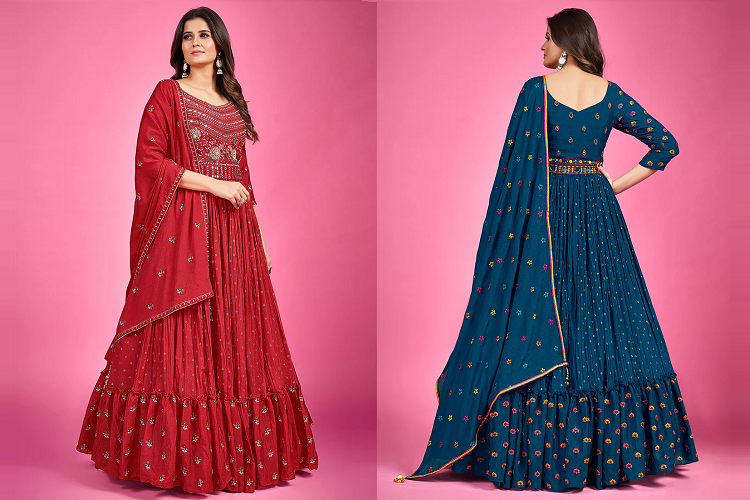In the world of fashion, some trends come and go, but a few stand the test of time and remain eternal symbols of grace and charm. Among these, the Anarkali suit has emerged as an iconic Indian attire that encapsulates the essence of regal splendor and timeless elegance. With its rich historical roots, evolution, and enduring popularity, the Anarkali suit has carved a niche for itself in the hearts of fashion enthusiasts across the globe. In this guest post, we will delve into the captivating journey of Anarkali suits, exploring their origin, design elements, cultural significance, and the contemporary appeal they hold in modern-day fashion.

Origin and Historical Significance of Anarkali Suits
The history of Anarkali suits dates back to the Mughal era in the Indian subcontinent. Legend has it that these enchanting outfits were inspired by Anarkali, a legendary courtesan in the court of Emperor Akbar. Her ethereal beauty and mesmerizing dance performances became the muse for the creation of the Anarkali dress, which was an exquisite fusion of Mughal and Persian aesthetics.
During this time, Anarkali suits were characterized by their long, flowing silhouette, pleated kalis (panels), and a form-fitting bodice that accentuated the curves of the wearer. They were adorned with intricate embroidery, delicate zari work, and precious gemstones, signifying opulence and grandeur.
Design Elements and Features of Anarkali Suits
Anarkali suits are a celebration of femininity, crafted to complement and flatter women of all body types. They consist of three main parts: the kurta (tunic), churidar (skinny trousers), and dupatta (scarf). Over the years, these suits have undergone various modifications, blending traditional elements with contemporary influences to cater to evolving fashion trends.
The key design elements of Anarkali suits include:
- Silhouette: The hallmark of an Anarkali suit is its flared and voluminous silhouette, often referred to as the “umbrella” or “floor-length” style. This characteristic creates a regal aura, making it a popular choice for special occasions like weddings, festivals, and parties.
- Embellishments: Intricate embroidery, zari work, sequins, beads, and mirror work are integral to Anarkali suits. These exquisite embellishments not only add richness to the outfit but also enhance its visual appeal.
- Neckline and Sleeves: Anarkali suits offer a wide array of neckline and sleeve options, ranging from classic round necks and V-necks to trendy halter necks and boat necks. The sleeves can be full, three-quarter, or even sleeveless, catering to individual preferences.
- Fabrics: From luxurious silk and velvet to lightweight georgette and chiffon, Anarkali suits come in a variety of fabrics, each lending a distinct charm to the ensemble.
Cultural Significance of Anarkali Suits
Anarkali suits hold profound cultural significance, reflecting the rich heritage of Indian traditions. These resplendent outfits are deeply rooted in Indian festivities and celebrations, making them an integral part of various ceremonies, including weddings and religious occasions.
Moreover, these suits exemplify the timeless fusion of Indian and Persian design sensibilities, reflecting the multicultural essence of the region. As a result, they have transcended boundaries and are embraced by women worldwide, making them a symbol of cross-cultural appreciation and admiration.
Contemporary Appeal and Versatility
While suits originated centuries ago, their appeal remains undiminished in the contemporary fashion landscape. Designers and fashion houses have reinvented suits, infusing them with modern elements to suit the preferences of today’s fashion-forward clientele.
The versatility of Anarkali suits is noteworthy, as they can be styled in numerous ways to create a look that befits various occasions. They are available in an array of colors, patterns, and embellishments, catering to diverse tastes. Additionally, the adaptation of the Anarkali silhouette in western wear has further expanded its reach, attracting fashion enthusiasts from different cultural backgrounds.
Anarkali suits stand as an epitome of timeless elegance and grace, rooted in centuries of history and cultural heritage. With their luxurious fabrics, intricate designs, and enchanting silhouettes, these outfits continue to captivate the hearts of fashion enthusiasts worldwide. As we look towards the future, one thing remains certain – the Anarkali suit will continue to inspire and mesmerize generations to come, symbolizing the enduring allure of Indian fashion and the beauty of traditions passed down through the ages.


